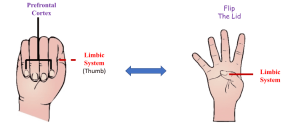Brain architecture can be a hard thing to understand, especially when looking at emotional regulation. A great way to never forget the basics of brain architecture is using what Dan Siegel calls the “Hand Model of the Brain”. Let’s walk through the model together.
Hand Model of the Brain
Hold your hand up, either one. Make a number four with your fingers and your thumb pulled in. Now fold your fingers on top of your thumb.
This is a model of your brain. The front part of your fingers is the prefrontal cortex, in this case the upstairs brain. This area is responsible for logical thinking, calming, flexibility and focus, etc. It puts language into emotions, e.g. “I feel…”. This the last part of the brain to develop. Now lift your fingers. This area represents the downstairs brain; the thumb and palm. These areas represent the limbic system; they are responsible for keeping you safe by watching out for danger and producing strong emotions like anger and fear. The thumb itself represents the amygdala. This is the watchdog of the brain (Siegel) because it is taking in information from other parts of the lower brain and acting to keep you safe through fight, flight, or freeze. The downstairs brain is responsible for keeping you safe or saving your life. One thing to note is that the downstairs brain is responsible for intense emotions, which means that thinking and reasoning don’t happen here.
Let’s Take a Walk
Now let’s take our whole brain and go for a walk. It is a nice day; sun is shining; there is a nice breeze. You can hear the wind rustling the leaves. You are relaxed.
As you are walking you turn a corner and see a bear. The first thing that happens is the amygdala senses a threat and sets off an internal alarm.
At this point you “flip your lid” (see diagram) and the emotional, downstairs brain takes over. The amygdala through the alarm tells the body to fight, flight, or freeze. In this case, many people run. This response is what keeps us safe. After we run and are away from the bear, maybe back in our car, our thinking, upstairs brain starts to work with our downstairs brain again to think through what just happened.
Our body starts to relax again. Our upstairs and downstairs brain are now attached. In this scenario we are supposed to flip our lids to keep us alive.
Brain Experiencing Trauma
In contrast, let’s look at another situation where the brain has experienced or is experiencing trauma. In this scenario you are a second-grade student lining up to go to lunch. As you are walking to get in line a fellow classmate runs into you. Since you are experiencing trauma and toxic stress, your stress response cycle is on high alert and your amygdala senses a threat and immediately reacts.
You “flip your lid”. This decreases any connection with the upstairs brain, and you move into a survival state and you flight, flight, or freeze. As a result, you punch your classmate.
In this scenario, there was no visual danger present, but there was a perceived threat of safety for you, the child. From an outsider’s perspective there was no need for you to “flip your lid”.
A teacher may assume that you hit your classmate because you are an aggressive student. However, you have a teacher who understands how trauma impacts the brain and sees that your behavior is a result of your brain in survival mode. You don’t have a strong connection between your downstairs, emotional brain and upstairs brain, thinking brain because of your experiences.
Please note that I am not saying that hitting is okay. What I am saying is that as adults we need to be aware of why behavior may happen and what behavior may be communicating. Check out future blogs to learn more about behavior as communication.
 0
0

